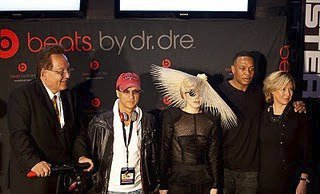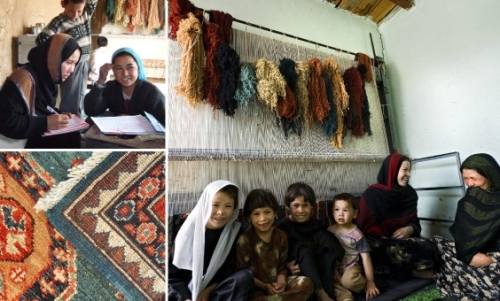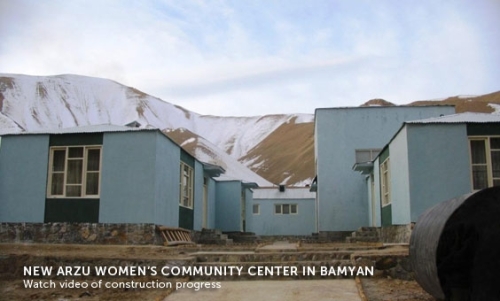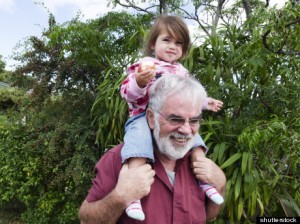Former CEO of Product (RED) on Getting Off and On the Career Track
 Susan Smith Ellis writes for Grown and Flownreaders about the challenges of going back to work after stepping off the career track to be at home with her children.
Susan Smith Ellis writes for Grown and Flownreaders about the challenges of going back to work after stepping off the career track to be at home with her children.
Eighteen years ago, after a successful career in advertising, I decided not to go back to work when I found out I was pregnant with our second child. It seemed to me that being home with our daughter and son, born sixteen months apart, would be my new job. I had lived and worked all over the world and while I thrived on that, I was ready to embrace full time motherhood. When the children started school I became restless and found that it was hard to fill my days in a rewarding way. I started to look into picking up where I left off. It was really discouraging! Over and over again I was told that my six-plus year hiatus had rendered me unemployable at anything resembling the level of seniority and compensation I had worked so hard to achieve. It was suggested that I find work at a non-profit. Perhaps I might volunteer.
I could forget resuming my career. I was, as they say, “toast.”
The more rejection I faced, the more determined I became to prove that motherhood is not a career liability. I pressed on, lucky to have several women friends in New York who took up my cause. With their help opening doors, I was quickly offered a senior position at a premier New York ad agency, being paid every bit as much as if I had never left the working world. But accepting the job meant selling a beautiful old house we had restored and leaving our friends and family in Boston. It was hard to do and sad to say good bye but off we went.
Back at work, I found it hard to not feel guilty nearly all the time. When I was at the office, I missed my children and always felt like I was a step behind all of the stay-at-home mothers who seemed to know everything about school and teams and activities. They also managed to look so pulled together at school events while I always dashed in late and harried. But my career continued to track well and I loved the energy of New York City and the competition of work.
Once I achieved a certain level of success I was again restless even though I had a pretty good “work-life balance”. So I jumped again to a very tiny start up that was in need of a CEO to turn it into a brand and a going concern. It was the antithesis of the large, resource-laden firm I was leaving. The name of that start-up was Product (RED), founded by U2’s Bono with a mission to raise money (through the sale of (RED)-branded products) to buy anti retroviral medicine for people with HIVAids in Africa.
It was my children who persuaded me to take this job. They said I would be using my skills to do good in the world rather than the “boring” work (as they called it) I had been doing.
As it turned out, we had great success, raising $180 million in three and half years. It was crazy and frenetic, as all start-ups are, but it was also great fun. And I could never replicate the opportunities I was given to be engaged in creative and meaningful work and to travel to Africa to see first hand the impact of our work.
Last year I faced another turning point. Our daughter was finishing high school and I wanted to be around more to look at colleges with her and to spend time as a family without checking my Blackberry every two minutes. So once again, I stepped away from my career.
While I continue to serve on several boards, I really have spent most of my time being more than doing. It has been heavenly. But as night follows day, I’m starting to get restless again. I am taking on more projects (I am executive producer of a documentary, Get the Picture, and am helping a small start up company.)
And now our son is beginning to look at colleges. In a little more than a year, we will be facing the prospect of our youngest heading off to college and we will be empty nesters. Will I wish then that I had a career again to fill the void?
So I have begun to have conversations about maybe getting back in the game. And already I have had some people say that now that I have taken the last year off, it will be hard for me to get hired. Or I am told that I probably best-suited for the non-profit world. In the words of Yogi Berra, “It’s déjà vu all over again.”

Share this:
And I Thought, Those Could be My Children
There are certain things that you’re just passionate about and it could be anything. Mine has always been women’s rights, and particularly women’s economic empowerment. That has been my personal soapbox, I think since I was in high school. –Connie Duckworth, founder and CEO, Arzu Studio Hope
Credit: Arzu Studio Hope
In 2003, Connie was a retired partner of Goldman Sachs. She had four school age children and a calendar full of board and speaking responsibilities. She wasn’t looking for anything in particular, but she was looking. This interview is the story of her journey from Wall Street partner to social entrepreneur, from working in a world of privilege to one in which the need is overwhelming. Arzu Studio Hope commissions women in Afghanistan to weave top quality rugs for sale in the United States and Europe. ARZU addresses three interdependent needs: consistent and improved employment, access to education, and access to basic healthcare, with a particular focus on maternal and infant care.
You really don’t really have an international affairs background?
No, not at all. And I had never done anything remotely in Washington. But I looked at this and I thought, “Wow, this is exactly my sweet spot.” Here we’re talking about the most abused women on the face of the Earth, which is my passion, and it’s in the international arena, which I was becomingly increasingly interested in.
When you sort of look up from your day-to-day life and post 9/11, I think we all were jolted into a new reality about the larger world. So it just was like being in the right place at the right time. I was asked to join this commission. It’s called the US Afghan Women’s Council.
But we had just forced the Taliban out along with the whole coalition. It just was a topic that was extremely interesting to me, but I didn’t have any particular qualifications for this and didn’t know what I was expected to do. And that’s part of the journey aspect of all of this. We had few conference calls and meetings and then in January of ’03 we got on a military plane and we flew into Kabul.
It was the most extraordinary trip I’ve ever taken. It really was the catalyst, if you will, for this embarkation on the journey that I’m now on in terms of having founded Arzu.
I didn’t know how to respond, basically. It was like going back in time two thousand years. It was so different in every way from anything that I had ever experienced in our culture here. Kabul looked like Berlin after World War II. It had just been flattened in the various bombings.
We went to a bombed out school building, a cinder block building and as it was January the temperature was in the twenties. There were dozens of women and children living in this bombed-out building, no windows, no heat, no electricity, no running water, no food, no furniture trying to live through the winter, squatting through the winter. I looked at these children’s faces-that goes back to it could be me-and I thought those could be my children. I literally went back on the plane and thought, “I am doing something, I don’t know what it is, but I am doing something.”
We see the world through our own lens and my lens is business. So my response, basically to this situation is that these women needed jobs. Because it goes back to the power of the purse and my personal belief that economic empowerment is the driver for women’s larger empowerment.
And so I hired a young woman part-time who had worked at the UN to help me do some research. I tried to think whether I could encourage industries to bring factories into Afghanistan. The fact of the matter is, particularly years ago – this was still basically a war zone, and it was just not realistic to expect private capital to come in and invest
There was no civil society and no education. This is a country that has nothing. It was a disaster of epic proportions on every single level of society: environmentally, health-care-wise, education, rule of law. It’s the most heavily land mined country in the world… just huge hurdles.
Through that research, I went ahead and I incorporated a 501c3 (a non-profit) with the mission of Arzu, which is to in effect try to help restart the rug industry, which had been a very vibrant industry for centuries.
Credit: Arzu Studio Hope
What state was the rug industry in then at the beginning of 2003?
There had been massive dislocation because of almost twenty-five years of war. The supply chain was disrupted and the reputation of the Afghan carpet on the international markets had fallen way off because the materials were shoddy. The weavers themselves were displaced. Millions were in refugee camps in Pakistan. The whole rug industry was in disarray. But the reason that I hit on that was it was one of the only things that I could see that women could actually do that was culturally acceptable because they could do it in their homes.
How did you come up with the idea, do you remember?
The rug? Basically by starting to look at Department of Commerce data and UN data on industries and economic flows in Central Asia. Even the U.S. Department of Commerce had a white paper that said that the rug industry was probably Afghanistan’s best near-term hope for a legal economy. Because there’s obviously a huge opium trade, though that tends not to be women.
So I started picking up the phone and calling rug people.
What were you asking them?
I was saying this is who I am. I’m trying to think of ways to plant some seeds in the private sector in Afghanistan. Can you help me? They all took my calls; they all met with me and gave advice. And that’s how I learned about the rug industry.
Because when I started this, truly, I knew nothing about Afghanistan, I knew nothing about rugs and I knew nothing about international development. But I know about business. I guess the lesson is that it’s just like starting a new job, trying to attack one of these social problems that you’re interested in. You really don’t know how to do it until you start, but you just have to start. You just have to show up the first day and you learn.
So anyway it was one foot in front of another. I had one rug expert tell me there was no way we could do this, no way it would ever work. What did I know about rugs? Well he was right, I didn’t know anything about rugs and then I met with the same guy about six months later and went through where we were and he said, “You know you have learned a lot in the last six months.”
But it’s still a big leap from getting advice to actually getting up and running…
That’s right. A lot of it was sort of common sense and again I think about this organization that we’ve created over there very much like a business. It’s a charity, I work completely pro bono and all of the proceeds from the rugs go to support the organization and the mission. But mentally I think about wanting it to be very, very profitable because what we’re trying to do is to create what people in international development have told me is a “new template in post-conflict reconstruction”. The first time I heard that I was like, “Well we’re just trying to do a little rug business.” It’s bringing private sector thinking to a public sector problem. I think not having any kind of international development background was probably helpful in a way because I didn’t have any of the biases about how things should be done. We just made it up as we went along.
So we started with a staff of one half-time person working and later we hired a full-time person here in Chicago. We’re now up to a staff of about twenty people, most of whom are in Afghanistan. We have fifteen people in Afghanistan, all Afghanis. That was one of the decisions. Again we set the ground rules, because we were creating this thing and made it up as we went along. One of the rules for us is that this is not about is us. It’s about them.
That’s the new template for international development. We are creating real work there. We’re talking about very high-quality, export quality, high-end, natural-dye carpets that you would be proud to have in your home.
Interview excerpted from Be the Change, by Lisa Endlich.
To receive an email with each new Grown and Flown post, please leave your address in the upper right hand corner. We will send you only our writing, nothing else.
Back on the Career Track, pt. 2
 Carol Fishman Cohen, co-founder of irelaunch, returns today with some concise words of advice for anyone looking to reignite a career or maybe change direction. She gives us some great personal stories that we hope will provide inspiration and direction.
Carol Fishman Cohen, co-founder of irelaunch, returns today with some concise words of advice for anyone looking to reignite a career or maybe change direction. She gives us some great personal stories that we hope will provide inspiration and direction.
If you want to hear more Carol gave a great interview with Better After 50 (BA50) and you can read it here.
5 ways to relaunch a career:
1. The Volunteer Relaunch
- After a 15 year career break, Jenny Brody founded the DC Volunteer Lawyers Project to provide pro bono representation to low-income clients in family law cases. The non-profit has now secured funding and has 450 lawyers involved.
- Another lawyer, Deborah Felton, spent most of her 15 year career break as a community activist, including increasingly senior volunteer roles at a senior housing community. When the housing community was looking for a new (paid) Executive Director, Deborah was their first choice.
2. The Back to School Relaunch The benefits of going back to school only begin with what you are learning in the classroom. You have access to career services, exclusive job listings and internships, and networking opportunities with professors and fellow students.
- Belinda Nanda, an IT consultant who had taken a 10-year career break, took IT courses at a local community college to update her skills. She applied for an internship posted at the community college to work at an electronic medical records management company. Instead of being offered the unpaid internship, she was offered a permanent position.
- Cindy Rawlings completed a Certified Financial Planning Certificate at Northwestern University at the end of her 20 year career break and subsequently returned to work at North Shore Community Bank as part of their commercial banking group. She has worked in increasingly senior positions in the 6 years she has been back at work.
- Debbie Krasnow, a former public relations executive, went back to school for a degree in social work at the end of her 15 year career break. She is now a social worker working with at-risk women and their families at a non-profit.
3. The Internship Relaunch
- Erika Grinius transitioned from a career as a social worker to a career in business. She was in the part time MBA program at University of Chicago Booth School of Business when she saw a listing for an internship at Whitney Automotive Group, the largest online retailer of auto parts in the country. The internship turned into a permanent position, and Erika got a promotion upon receiving her MBA degree. She subsequently transitioned to a position as Director Target Marketing, E-commerce, for Walgreens.
4. The Career Reentry Program Relaunch.
- Dr. Margaret Rayman relaunched her career via the Daphne Jackson Fellowship program in the U.K., which enables professionals in scientific and technical fields to relaunch careers after career breaks. Following a 15 year career break, Dr. Rayman returned to academia and is now a tenured professor at the University of Surrey.
5. The Entrepreneurial Relaunch.
- Kris Hintz founded Position U4 College after a 15 year career break. A former consumer marketing executive, she completed a part time Masters Degree program in Psychology and also focused on personal coaching and counseling. ”My relaunch has been tremendously gratifying thus far. I am happy to share my experience with other empty-nesting parents who want to leverage their experience and talents in a new entrepreneurial career!”
- Ann Levin was a former advertising executive who took a 20 year career break to care for her children, and ultimately, her mother, who had suffered a debilitating stroke. Her experience caring for her mother and orchestrating the downsizing of her home and relocation to an assisted living facility was the genesis of her business idea. Now her company Senior Move Partners does this work for other seniors and their families.
Back on the Career Track
 Is it time to go back to work? Or maybe time to change career paths with the kids on the way out the door? As the nest empties, these questions naturally arise. But where to begin? If you have been out of the workplace for a number of years, dare we even say a decade or more, a job search with a dusty, outdated resume can be a daunting task. One of my oldest friends, Carol Fishman Cohen, became a stay at home mom when the company she worked for (remember Drexel Burnham Lambert?) went into bankruptcy while she was on maternity leave. A decade later Carol was successful in finding a great job, but ultimately her real calling was in helping others tread the same path. Carol wrote a great book called Back on the Career Track and she has a hugely helpful website called www.irelaunch.com. I went to one of Carol’s conferences last fall at NYU and it was an amazing networking/information gathering/educational event—even the food was good. So rather than speak for her, I have asked Carol to give you a few of her most important points, and if you need more you can follow up on her site or at Amazon. Today Carol is going to talk about mistakes people make in trying to renter the workforce, tomorrow she will give some of her top suggestions on how to get back on the career track.
Is it time to go back to work? Or maybe time to change career paths with the kids on the way out the door? As the nest empties, these questions naturally arise. But where to begin? If you have been out of the workplace for a number of years, dare we even say a decade or more, a job search with a dusty, outdated resume can be a daunting task. One of my oldest friends, Carol Fishman Cohen, became a stay at home mom when the company she worked for (remember Drexel Burnham Lambert?) went into bankruptcy while she was on maternity leave. A decade later Carol was successful in finding a great job, but ultimately her real calling was in helping others tread the same path. Carol wrote a great book called Back on the Career Track and she has a hugely helpful website called www.irelaunch.com. I went to one of Carol’s conferences last fall at NYU and it was an amazing networking/information gathering/educational event—even the food was good. So rather than speak for her, I have asked Carol to give you a few of her most important points, and if you need more you can follow up on her site or at Amazon. Today Carol is going to talk about mistakes people make in trying to renter the workforce, tomorrow she will give some of her top suggestions on how to get back on the career track.
Three common mistakes people make when trying to relaunch a career:
Mistake #1 Not doing a career assessment. That was my big mistake. I thought that I should return to a finance career simply because I left a finance career. Once I was back in my finance position for about a year I realized I didn’t really want to do financial analysis anymore. I loved business writing and working with people so that’s why I transitioned to what I’m doing now. But I involved a very progressive employer who was willing to hire me after 11 years out of the full time workforce when I could have avoided the situation entirely if I had done a career assessment first. In Back on the Career Track we approach career assessment via our Job Building Blocks Worksheet. This is a framework for looking at each of your prior significant work and volunteer experiences, breaking them into components, identifying which of those components you love and are best at, and then using them to build a new career path for yourself.
Mistake #2 Getting completely professionally disconnected. This was another big mistake I made. I barely even read the newspaper for the six years I was home full time with my four little kids. So I had to go through a self-directed study program to get myself up to speed in the business world generally and then I did specific updating work on financial products, calculations, and analysis. Now there are formal programs which can help you do this, but back in 2000 and 2001, these programs did not exist. For our listing of career reentry programs worldwide, click here.
Mistake #3 Conducting your relaunch efforts at your computer. Instead, you need to get out of the house and meet people in order to get job market intelligence that leads to real opportunities. We call it “Get Out and Get Personal!” This means going to social events, professional conferences, and events put on by professional associations or your alma mater, including reunions! This is hard work. Because if you put yourself out there, you need to prepare yourself to speak with people about what you want to do. This requires practice. You need to speak with non-judgmental friends and family while you are practicing talking about yourself and what you want to do. Then you can move on to people you know less well. Essentially, you are doing interview rehearsals. The more of these conversations you have, the better you will sound when it counts, in the interview itself.
Tomorrow, Part 2 of Back on the Career Track










![70s2[1]](https://grownandflown.files.wordpress.com/2012/05/70s211.jpg?w=300)




